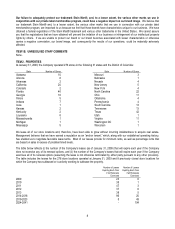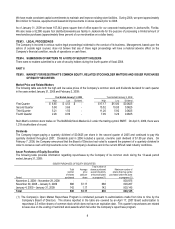Stein Mart 2008 Annual Report Download - page 20
Download and view the complete annual report
Please find page 20 of the 2008 Stein Mart annual report below. You can navigate through the pages in the report by either clicking on the pages listed below, or by using the keyword search tool below to find specific information within the annual report.later of the period that the merchandise markdown is incurred or the allowance is negotiated. Allowances received from vendors
related to damaged/defective inventory are reflected as reductions to the cost of merchandise as it is received. Allowances received
due to compliance issues (primarily violations of shipping and merchandise preparation requirements) are reflected as a reduction of
the cost of the merchandise when negotiated. Although it is unlikely that there will be a significant reduction in historical levels of
vendor support, if a reduction were to occur, the Company could experience higher cost of merchandise sold.
Impairment of Long-Lived Assets. The Company follows Statement of Financial Accounting Standards (“SFAS”) No. 144,
Accounting for the Impairment or Disposal of Long-Lived Assets. Long-lived assets are reviewed for impairment whenever events or
changes in circumstances indicate that the carrying amount of an asset may not be recoverable. Factors used in the review include
management’s plans for future operations, recent operating results and projected cash flows. For long-lived assets held for use, an
impairment loss is recognized if the sum of the future undiscounted cash flows from the use of the assets is less than the carrying
value of the assets. The amount of the impairment charge is the excess of the carrying value of the asset over its fair value. Fair
value is based on estimated market values for similar assets. Impairment reviews are performed for individual stores during the fourth
quarter, or more frequently should circumstances change. A significant change in cash flows or estimated market values could result
in an increase in asset impairment charges. The economic downturn experienced during 2008 had a significant impact on the retail
industry and our operating results. As a result, during the fourth quarter of 2008, we recorded $20.7 million in pre-tax asset
impairment charges related to stores closed in 2008, stores closing in 2009 and certain other under-performing stores.
Store Closing Costs. The Company follows SFAS No. 146, Accounting for Costs Associated with Exit or Disposal Activities, to
record store closing costs. SFAS No. 146 requires the recognition of costs associated with exit or disposal activities when they are
incurred. Lease termination costs are recorded net of estimated sublease income that could reasonably be obtained for the
properties. In the event the Company is not successful in subleasing closed store locations, additional store closing costs may be
recorded.
Insurance Reserves. The Company uses a combination of insurance and self-insurance for various risks including workers’
compensation, general liability and associate-related health care benefits, a portion of which is paid by the covered employees. The
Company is responsible for paying the claims that are less than the insured limits. The reserves recorded for these claims are
estimated actuarially, based on claims filed and claims incurred but not reported. These reserve estimates are adjusted based upon
actual claims filed and settled. The estimated accruals for these reserves could be significantly affected if future claims differ from
historical trends and other actuarial assumptions. As of January 31, 2009 and February 2, 2008, insurance reserves of $16.4 million
and $16.0 million, respectively, were included in accrued liabilities. Adjustments to earnings resulting from changes in trends and
other actuarial assumptions have not been significant in 2008, 2007 and 2006.
Valuation Allowance for Deferred Tax Assets. SFAS No. 109, Accounting for Income Taxes, requires that companies assess
whether valuation allowances should be established against their deferred tax assets based on consideration of all available evidence
using a "more likely than not" standard. In making such assessments, significant weight is to be given to evidence that can be
objectively verified. A company's current or previous losses are given more weight than its future outlook, and although the Company
was profitable in 2006 and posted a small loss in 2007, the results in 2008 produced a cumulative three-year loss, which is considered
a significant factor that is difficult to overcome.Accordingly, the Company established a deferred tax asset valuation allowance of
$19.0 million through a charge to tax expense.
Income Tax Reserves. The Company records liabilities for uncertain tax positions related to federal and state income taxes in
accordance with FASB Interpretation No. 48, Accounting for Uncertainty in Income Taxes. These liabilities reflect the Company’s best
estimate of its ultimate income tax liability based on the tax code, regulations, and pronouncements of the jurisdictions in which we do
business. Estimating our ultimate tax liability involves significant judgments regarding the application of complex tax regulations
across many jurisdictions. If the Company’s actual results differ from estimated results, the Company’s effective tax rate and tax
balances could be affected. As such, these estimates may require adjustment in the future as additional facts become known or as
circumstances change.
For a complete listing of our significant accounting policies, see Note 1 to the Notes to Consolidated Financial Statements.
Recent Accounting Pronouncements
In June 2008, the Financial Accounting Standards Board ("FASB") issued FASB Staff Position ("FSP") Emerging Issues Task Force
("EITF") No. 03-6-1, Determining Whether Instruments Granted in Share-Based Payment Transactions Are Participating Securities.
FSP EITF No. 03-6-1 addresses whether instruments granted in share-based payment transactions are participating securities prior to
vesting, and therefore need to be included in the earnings allocation in computing earnings per share under the two-class method as
described in SFAS No. 128, Earnings per Share. Under the guidance of FSP EITF No. 03-6-1, unvested share-based payment
awards that contain non-forfeitable rights to dividends or dividend equivalents (whether paid or unpaid) are participating securities and
18
























